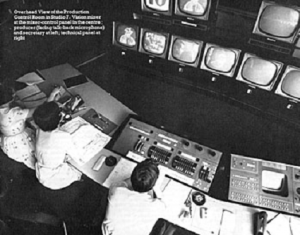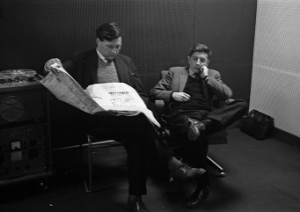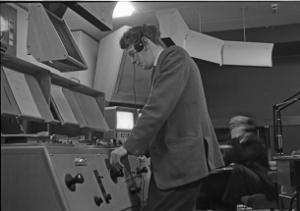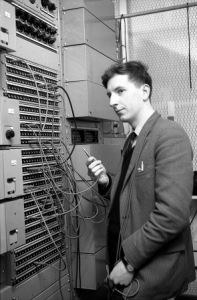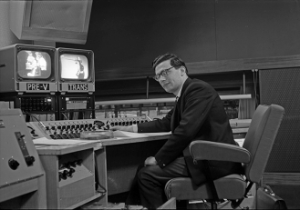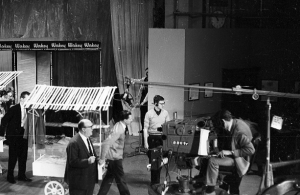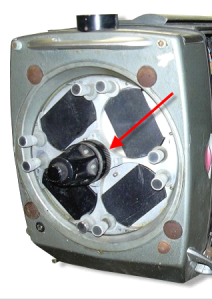Background
Production Gallery – and VM
Clive Doig
I did VM for Rudolph Cartier with Paddy Russell screaming at him from the floor, on “The July Plot”, “Alexander the Great” and “Rembrandt” in the mid 60s, but I cannot find any reference to the latter two productions anywhere on IMDb or BBC Archives or BFI, so I might be going mad in my memories. Paddy and Rudy’s altercations were priceless, when he would regularly threaten to sack her and she would use disrespectful perjoratives to the ‘silly old fool’ in the gallery and not allow him to come down on to the floor.
Is my memory playing me tricks?
I am sure I can remember Rudy saying “Vot iss zis bomp!” when an unfortunate extra playing a Nubian slave stepped on a rostrum and his extra weight on one side, made the whole of Darius, the King of Persia’s throne dais, clonk audibly down onto the studio floor. Maybe whoever pointed out the “bomp” from sound can remember the incident. Rudy simply removed the extra from the scene!
David Brunt
REMBRANDT
18.12.1969
A BBC production for BBC 2 made in association with N.E.T., USA.Written by Carl Zuckmayer; designed by Tony Abbott; produced and directed by Rudolph Cartier.
ADVENTURE STORY
12.06.1961
Written by Terence Rattigan; play production by Rudolph Cartier.
Sean Connery (Alexander, King of Macedon),
Margaretta Scott (Queen Mother),
William Russell (Hephaestion),
Lyndon Brook (Philotas),
Paul Stassino (KingDarius),
William Devlin (Parmenion, Philotas’ Father),
Rachel Blayney – VM
Geoff Fletcher
I remember Rachel as she used to cause the odd red face when a cameraman (or tracker) repositioned or swung a lens on shot. Now I may have this wrong as many moons have passed, but I was told it was because she preset the next shot up on (say) the B bank while the live shot was up on the A bank, and then used the A/B cut buttons to put the next shot to air. There would be an audible click from (say) the B bank button when she did this, and the unwary cameraman or tracker would react to this click instead of watching his cue light, and move or swing a lens thinking she had cut away from him. It certainly happened to me a couple of times, and I remember Reg Poulter reminding all of us, and especially us junior lads, to be aware as Rachel was mixing. Some jolly Crew 4 joker may well have invented this explanation, but I have since always believed it to be the case.
Dick G
You are right Geoff she did use the A and B banks so that the next shot was on view on the preview monitor, next to the TX monitor – a great help to sound and lighting.
She was my favourite VM – SO reliable.
Clive Doig
Rachel Blayney taught me to knit, as it was a requirement, I believed, to be a perfect vision-mixer. I knitted a large yellow-jersey during a George Foa play in Studio D, as Geoff Feld may remember. He photographed me wearing it on top of the TV Centre Roof precariously standing on the edge of the then unrailed lift housing. However I never shelled peas on the gallery vision-mixer, as did Gladys on the Black and White Minstrel Show during Saturday rehearsal.
Olive Dong (my pseudonym ever since that was printed on my name badge at a Bayerishche Rundfunk convention: “Fraulein Olive Dong – BBC delegate”)
The Sound Gallery
Patrick Heigham
Gram Op Denise Daveluy was usually given fairly simple programmes. I remember that she was working in LG D and had brought in her pet tortoise, and scrounged some boards from the scene boys to build an enclosure round the sound gallery. A sign on the door said "Tortoise loose" or similar!
Geoff Fletcher
Here are a few pics… taken in TC5 Sound on 16 March 1964 when Crew 4 was working on a CETO programmes (2 in the day).
Michael Cotton
Billy Cotton in the TV Theatre – taken from the Lighting/Vision Control “Gallery” in TVT .
The "Emu" on the Mole Crane and Harry Rab conducting the band from the prompt corner. and Michael Hurll FMing.
Len Shorey
This Billy Cotton photo reminds me of my first mix of the show. I was acting SS – keen as mustard and ears like a Moose!!
Sitting plum centre front row was the banjo player and I could not hear it so I started rigging a mic for him, this brought hoots of laughter from the band and a big smile on his face. “I can’t play this thing it’s got elastic strings!”. He was part of Bill’s comedy team who would go into routines throughout the show, the banjo was his prop.
Pat Heigham
I remember that on Crew 3, we worked the “Billy Cotton ban Show” on alternate weekends with the “Black and White Minstrel Show”.
On the late Friday(query) band call for Cotton, Adrian (Yogi) let me do the balance on the band. To my great pleasure, I noted that the transmission balance wasn’t different!
My other memory of the “Wakey Wakey” was to go into the Orchestra area before transmission, and remove all the empty gin bottles from under the musicians’ feet!
Sound Assistants had to be fairly flexible, then!
The Lighting and Vision Control Gallery
Lighting / TM1
Geoff Hawkes
Otis Eddie! I vividly remember meeting him on the stairs from the gallery of Studio E, when with usual menace in his voice he was complaining about someone’s performance and saying “…I’m just going down there to crack the whip.” If anyone knew how to put the fear of God into us, he did. If something went wrong, “Otis would notice” and we’d be for it. Even today I still mutter with amusement, “Did you notice, Otis?” and wonder if he’s up there somewhere taking notes, ready for the final reckoning.
Vision Control
Alec Bray
Whether it was because I had expressed some idea of moving into Engineering (“Racks”) or whether it was part of the normal rotation, I spent some months in Vision Control as a Vision Operator. This mean sitting in the Lighting and Vision Control Gallery with the Lighting Supervisor, later TM1.
In TVC, the Lighting Gallery was the other side of the Production Gallery to the Sound Gallery, so that the TM1 and Vision Control Operator saw the backs of the production team.
Vision Control by the Vision Operator was a very useful job: – the idea was to make sure that the images from each of the studio cameras matched – and in particular, to make sure that the facial tones from each camera matched. The modern day equivalent is, I believe, the “Colour Timer”, defined as a process which adjusts the final print so that colours match from shot to shot, regardless of the film stock (or video) and camera used to shoot the scene.
On the Stagger Through, the VC operator did absolutely nothing. In fact, this was in the Job Description (not simply dossing about). All the controls were put into the middle of their travel at the start of the Stagger, and then left completely alone. The idea was that the senior lighting engineer, Lighting Director (or TM1 as they later became during my time) should light the scene such that the images from each camera matched – one angle was not hopelessly in shadow, for example.
Then, on the first run through, the Vision Control operator could start tweaking the controls a little – but again, the main emphasis was that the lighting engineer should balance the lighting. Most programmes allowed for a stagger and two run throughs, so on the second run through the Vision Control Operator would start to tweak a bit more.
Then came Transmission! The Vision Control Operator had a control for each camera (and the spare) so that was six controls in TC3 and TC4. Each control was on a quadrant, forward and back, which opened or closed the iris on the lens – this iris was driven from a motor mounted in the centre of the lens turret on all the Image Orthicons of the time (Marconi Mk III and Marconi Mk IV, EMI 203 and Pye Mk Vs.). The controls could be rotated – this adjusted the black level. And by pressing on the knob, the picture of that camera was sent to a preview monitor. As all the monitors had slightly different characteristics, this preview monitor was used to “eyeball” the picture match from camera to camera. Anyway, the Vision Control operator had a monitor for each camera, next to which was mounted a vertical oscilloscope on which was displayed a compressed trace of the picture waveform. The idea was that the operator checked the waveform for the black level – black in the picture should be at, or just above, sync level:, and then check for gain – make sure that there was no clipping of the whites in the picture. These controls were very roughly analogous to “brightness” and “contrast” in the picture. Above each quadrant control on the desk was a rotary control for the gamma correction – change the relative amplification of parts of the waveform – stretch the backs, compress the whites, that sort of thing. The idea was to check the picture for waveform “quality” and then preview the picture on the standard preview monitor to check that the perceived picture quality from camera 1 (let’s say) matched the picture quality from camera 2 (let’s say). Of course, picture quality on the preview monitor was most essential, so part of line up was to put the test image (white and black rectangles – generated by PLUGE!) on the monitors and check the peak white output using a light meter (can’t remember any settings!).
There were also similar controls for 2 VT machines and 2 TK machines (although picture matching to a film insert was a losing bet – the gamma characteristics and so on made it just about impossible ever to match Black and White film inserts to the studio pictures.
So, 6 cameras, 2 VTs, 2 TKs – 10 main controls and gamma correction – and two hands, constantly matching outputs.
I used to finish a programme absolutely drenched with sweat, trying to match these disparate sources to make sure that there was no obvious technical difference in picture quality as the Vision Mixer cut the shots.
One day I was on Vision Control in the Theatre (TVT). The Lighting and Vision Control Gallery was located on the Circle, by the Proscenium arch , to the left as you looked at the stage (we never used “Stage Left”, “Stage Right”, “Prompt” or “Off Prompt” in the TVT (in my time) as we viewed everything from the camera viewpoint). Racks were well hidden away in old dressing rooms well behind the rear of the stage.
We were doing a show with a well known American singer (can’t remember who) (and maybe with Stewart Morris. But can’t remember) with the basic TVT set up of a camera on a ped to the (camera) left of the stage, motorised Vinten on the floor of the theatre, Mole on the ramp and a ped on (camera) right. The camera on the ((camera) left of the stage had an Angenieux Zoom lens. This was after the TVT had been equipped with Pye Mk Vs, and as with all IO cameras at this time, if a ZOOM was used, the turret lenses had to be removed, then the Zoom lens fitted: with the Angenieux Zooms, this usually required bracing/support struts to be fixed from the camera top front to the zoom lens. (The Angenieux 10x35B zoom lens was designed to fit turret image orthicon cameras. The lens had an optical range of 35-350mm at f/3.8. The controls consisted of a focus servo module and a zoom servo module with a 4-push button shot box.)
All went well during rehearsals – well, I wasn’t touching anything! On Transmission, I needed to open up the iris on the camera a gnat’s: fine! But when I came to close the iris – to correct for white level – the iris didn’t close. Open it up a gnat’s again – fine: but it wouldn’t close. To try to control the picture quality, I was tweaking the gamma ratios and black level, but the general result was that the lady as seen on this particular camera was getting darker and darker. I was on talkback to Racks to try to resolve the picture quality.
We (eventually) had a break, and finally Racks clustered around the camera. It seemed that the iris control cog was engaging the Angenieux iris drive in one direction, but not the other!
The offending control!


